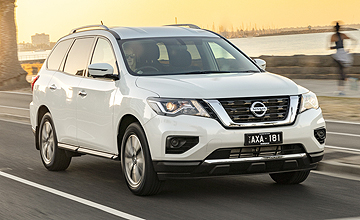BY ROBBIE WALLIS | 8th Apr 2019

Overview
Following its arrival in new-gen guise in 2013 and a significant facelift in September 2017, Nissan has given its Pathfinder seven-seat SUV another minor update with additional active safety equipment and the addition of a new variant.
Sitting between the base-level ST and mid-spec ST-L, the new ST+ grade brings the Pathfinder range to four variants, with the choice of either a 3.5-litre V6 or a 2.5-litre four-cylinder petrol hybrid set-up.
We took the ST+ V6 with all-wheel drive out for a week of testing to see if it can stack up with the best family SUVs on offer in the highly competitive large SUV segment.
Drive impressions
The current-generation Pathfinder first arrived in Australia in late 2013, switching from its Navara-based ladder-frame chassis roots to a more on-road oriented monocoque body to better compete with the likes of the hot-selling Toyota Kluger and Mazda CX-9.
Fast-forward to 2019 and the Pathfinder has undergone its second facelift, this time a fairly minor update introducing autonomous emergency braking, forward collision warning, blind spot warning, rear cross-traffic alert and active cruise control across the range, while the new ST+ grade builds on the specification of the ST and adds a surround-view monitor and satellite navigation.
While the Japanese car-maker’s large SUV contender has been updated for 2019, a step into its cabin reveals a car with elements that have clearly not been touched since 2013.
While many car-makers have embraced a minimalist style with their interiors and infotainment integration, the Pathfinder’s cabin moves in the opposite direction, with a dazzling and confusing array of buttons filling the dashboard.
Constituting the infotainment, media and air-conditioning controls, we counted no less than 48 different buttons, which makes for a dizzying experience when trying to navigate the various controls.
Furthermore, the buttons are finished in a cheap-looking grey plastic, and the 8.0-inch infotainment system is also beginning to look dated with mediocre usability and a jerky, low-resolution sat-nav system.
An overhaul of the car’s centre stack and infotainment would go a long way towards bringing it into the present day, and would be more valuable than any other visual or equipment upgrades.
Given its status as a large SUV, the Pathfinder’s interior dimensions are comfortable and roomy for first and second row occupants, with electric adjustment for the driver’s seat and sliding forward and backward adjustment for second-row pews.
Our only gripe is the fabric front seat bottoms are a little too flat and unsupportive, and while legroom is plentiful for rear occupants, the seats sit slightly too low to the ground, meaning your knees sit uncomfortably high.
Third-row seats are a struggle for full-size occupants unless the second-row bench has been slid all the way forward, but nevertheless ingress and egress is easy enough, and rear occupants still get cupholders and air vents.
Even with all three rows upright, boot space is still respectable with 453 litres and additional space under the boot floor, while total capacity is increased to 1354L with the third row folded and 2260L with the second row flat.
Given the Pathfinder’s sizeable dimensions (5042mm long, 1963mm wide), the addition of a surround-view monitor is a valuable one, however we were quite disappointed with the low resolution of the system’s cameras.
In this day and age, it is not difficult to source decent quality cameras and a system with better resolution would aid parking even more.
No changes have been made to the Pathfinder’s 3.5-litre V6, which still produces 202kW and 340Nm paired to a continuously variable transmission (CVT), with power sent to all four wheels via a selectable front-biased all-wheel drive system.
Nissan’s V6 motor is a quiet and capable unit, with plentiful power on offer and a smooth driving characteristic that lends itself well to everyday driving.
The engine is fairly responsive, however the same cannot be said of the CVT, which we struggled to warm towards.
Usually, we don’t mind CVTs when paired with underpowered engines in small cars, as the variable nature of the transmission helps extract the greatest level of performance from the engine.
In the case of the Pathfinder, where power is already ample, the CVT is sluggish under acceleration, reluctant to kick down and let the engine rev freely.
When using cruise control on the highway, we found the CVT struggled to maintain a consistent level of revs, constantly making minor adjustments which slowly became an annoyance.
A conventional automatic transmission would be better suited to the Pathfinder, such as the seven-speed auto found in the larger, V8-powered Patrol.
Official combined consumption for the V6 AWD grade is 10.1 litres per 100km, however over our week of driving we recorded a figure of 9.0L/100km – a rare feat.
On the road, the Pathfinder has a comfortable, soft suspension tune that lends itself well to a family SUV, one that is capable of floating over bumps and imperfections well, and offering good noise, vibration and harshness levels (NVH).
Steering, on the other hand, is dull and lifeless, and could use a greater level of feedback. Handling is generally mediocre; however, we won’t judge the Pathfinder too harshly for it as handling prowess is hardly at the top of the list of requirements for a seven-seat family SUV.
In this day and age, active safety equipment is becoming more and more important particularly to family car buyers, and we applaud Nissan for updating the Pathfinder to reflect this.
However, it still struggles to shine – while there aren’t any elements of it that make it a deal breaker for most buyers, the Pathfinder struggles to offer any features or characteristics that would place it ahead of its competitors, which is a problem in a segment as competitive as the large SUV.
For now, it will have to remain in the middle of the field, and we hope that when the new-generation version rolls around, a redesigned multimedia interface and conventional automatic transmission are high priorities.